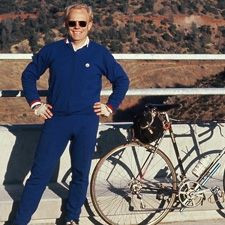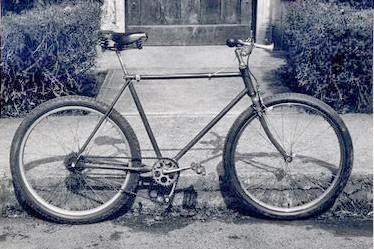John Finley Scott, a name perhaps not widely known, yet instrumental in shaping the landscape of modern cycling, particularly mountain biking. While his life was tragically cut short, his contributions resonate deeply within the cycling community, marking him as a true pioneer and visionary. This article delves into the life and legacy of John Finley Scott, exploring his pivotal role in the creation of the mountain bike and his insightful perspectives on cycling advocacy and transportation.
 John Finley Scott
John Finley Scott
The “Woodsie Bike”: Forerunner of the Scott Mountain Bike
In 1953, decades before mountain biking became a global phenomenon, John Finley Scott conceived and built what is recognized as the world’s first mountain bike. He christened it the “woodsie bike,” a testament to its intended purpose – conquering off-road trails and woodland paths. This innovative machine was groundbreaking for its time, featuring multiple gears and knobby tires, elements that would later become standard in mountain bike design. The “woodsie bike” wasn’t just a modified bicycle; it was a bold reimagining of what a bicycle could be, purpose-built for adventurous exploration beyond paved roads. Scott’s early vision laid the groundwork for the robust and versatile mountain bikes we enjoy today.
 woodsie-bike
woodsie-bike
Championing Cyclist Rights and Sensible Legislation
Beyond his invention of the “woodsie bike,” Scott’s influence extended into the realm of cycling advocacy. In the early 1970s, he played a crucial role in persuading the California legislature to adopt progressive traffic laws that recognized bicycles as vehicles. This was a landmark achievement, shifting away from outdated regulations that relegated cyclists to sidewalks and imposed unnecessary restrictions. Scott’s collaboration with activist John Forester proved highly effective, with Forester acknowledging Scott’s superior skills in navigating bureaucratic processes. Scott’s persuasive approach and understanding of legislative dynamics were instrumental in shaping California’s traffic laws, setting a precedent for other states and the National Uniform Vehicle Code. His work prevented a potentially detrimental future for cycling, ensuring that bicycles were treated with the respect and legal recognition they deserved on the roads.
Fueling the Mountain Bike Revolution: Scott’s Investment in Gary Fisher
John Finley Scott’s impact on mountain biking history is further solidified by his early support of Gary Fisher, a pivotal figure in the commercialization of mountain bikes. In the mid-1970s, Scott provided a crucial $10,000 capital injection to Fisher, enabling him to launch his mountain bike business. This financial backing was instrumental in transforming the mountain bike from a niche concept to a viable product. Fisher used the funds to acquire hand-built frames from Tom Ritchey and components, assembling and selling complete mountain bikes. At a time when many viewed mountain biking as a fleeting fad, Scott’s investment demonstrated his belief in its market potential. This early financial support was a catalyst, paving the way for industry giants like Specialized and Univega to enter the mountain bike market in the early 1980s, ultimately propelling mountain biking into the mainstream.
 1003420221image
1003420221image
Provocative Insights on Cycling and Transportation Sociology
As a sociology professor at the University of California, Davis, Scott challenged conventional thinking and encouraged his students to critically examine assumptions, particularly in his course on the sociology of transportation. He advocated for treating bicycles as vehicles, arguing against special treatment for cyclists and emphasizing the importance of cyclists adhering to traffic laws for their own safety. His perspectives, while sometimes contrarian to prevailing bicycle advocacy trends, were insightful and rooted in his understanding of societal norms and transportation dynamics. Scott recognized the enduring appeal of automobiles as “efficient status symbols” and questioned the potential for significant growth in bicycle commuting in car-centric societies. However, he also acknowledged the thriving culture of weekend recreational cycling, highlighting the multifaceted role of bicycles in modern life.
An Irreverent Spirit and Lasting Legacy
John Finley Scott was known for his provocative and often irreverent personality. He wasn’t afraid to challenge norms and express unconventional opinions, whether it was in his academic life, cycling circles, or online forums. This spirited nature, while sometimes leading to disagreements, was also a source of his unique insights and contributions. His tragic disappearance and murder in 2006 marked a devastating loss for the cycling community and all who knew him. Despite the circumstances of his death, Scott’s legacy as a mountain bike pioneer, cycling advocate, and insightful thinker endures. He will be remembered not only for inventing the “woodsie bike” and supporting the rise of mountain biking, but also for his enduring impact on cycling legislation and his thought-provoking perspectives on the role of bicycles in society. John Finley Scott’s contributions cemented his place as a foundational figure in the history of the mountain bike and a true visionary in the world of cycling.
Conclusion
John Finley Scott’s life, though tragically concluded, left an indelible mark on the world of cycling. From his pioneering “woodsie bike” – the original Scott Mountain Bike – to his impactful advocacy work and early investment in the mountain bike industry, his contributions are undeniable. He was a visionary who saw the potential of the mountain bike before it was widely recognized and a champion for cyclist rights. Remembering John Finley Scott is crucial for understanding the history of mountain biking and appreciating the individuals who paved the way for the sport and passion we celebrate today.


